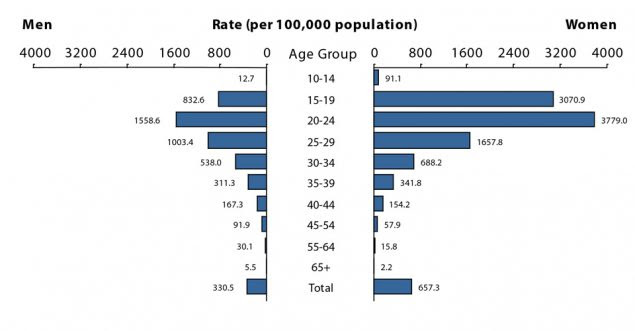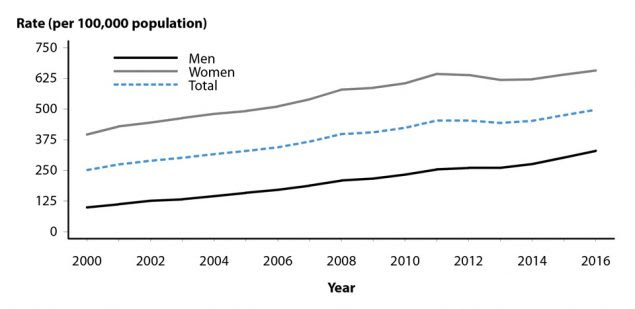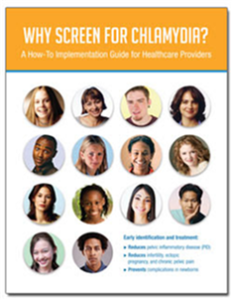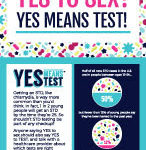April is “STI AWARENESS” Month
Chlamydia trachomatis, is the most common notifiable disease in the United States. It is among the most prevalent of all STDs, and since 1994, has comprised the largest proportion of all STDs reported to CDC (Table 1). Studies also demonstrate the high prevalence of chlamydial infections in the general U.S. population, particularly among young women.1
Chlamydial infections in women are usually asymptomatic.2 Untreated infection can result in pelvic inflammatory disease (PID), which is a major cause of infertility, ectopic pregnancy, and chronic pelvic pain. Data from randomized controlled trials of chlamydia screening suggested that screening programs can lead to a reduction in the incidence of PID.3,4 As with other inflammatory STDs, chlamydial infection could facilitate the transmission of HIV infection.5 In addition, pregnant women infected with chlamydia can pass the infection to their infants during delivery, potentially resulting in ophthalmia neonatorum, which can lead to blindness, and pneumonia. Because of the large burden of disease and risks associated with infection, CDC recommends annual chlamydia screening for all sexually active women younger than age 25 years and women ≥25 years at increased risk for infection (e.g., women with new or multiple sex partners).6
Chlamydia — Rates of Reported Cases by Age Group and Sex, United States, 2016

Figure 1: Chlamydia Rates
In 2016, a total of 1,598,354 chlamydial infections were reported to CDC in 50 states and the District of Columbia (Table 1). This case count corresponds to a rate of 497.3 cases per 100,000 population. During 2000–2011, the rate of reported chlamydial infection increased from 251.4 to 453.4 cases per 100,000 population (Figure 1, Table 1). During 2011–2013, the rate of reported cases decreased to 443.5 cases per 100,000 population, followed by an increase in the rate of reported cases over each of the next 3 years. During 2015–2016, the rate increased 4.7%, from 475.0 to 497.3 cases per 100,000 population (Figure 1, Table 1).
Screening for Chlamydia 8
Routine chlamydia screening is recommended for all sexually active adolescents and young women age 25 years and under. Women over age 25 with risk factors such as new or multiple sex partners, all pregnant women, and men who have sex with men, or are in high risk settings should also be screened. Chlamydia is easily detected from a swab or urine specimen and treated with antibiotics. Rescreening and treating sexual partners prevents re-infection. The National Commission on Prevention Priorities ranks chlamydia screening as a high value, but underused clinical preventive service. Chlamydia screening could reduce the incidence of pelvic inflammatory disease (PID) by up to 60%.

Why Screen for Chlamydia? An Implementation Guide for
Healthcare Providers covers the latest information and tools
for healthcare providers to improve delivery of chlamydia
screening to patients and make chlamydia screening and care
a routine part of a medical practice, including ways to:
- Improve the delivery of chlamydia screening and retesting
- Make screening for and treating chlamydia routine practice
- Provide confidential care to adolescents
Quality Measures
The Healthcare Effectiveness Data and Information Set (HEDIS) contains a measure which assesses chlamydia screening coverage of sexually active young women who receive medical care through commercial or Medicaid managed care organizations.
- Among sexually active women aged 16–24 years in commercial health maintenance plans, screening increased from 23.1% in 2001 to 47.4% in 2015.
- Among sexually-active women aged 16–24 years covered by Medicaid, screening rates increased from 40.4% in 2001 to 58.0% in 2011, then decreased to 55.2% in 2015. 7
- Although chlamydia screening has expanded over the past two decades, many women who are at risk are still not being tested—reflecting, in part, the lack of awareness among some health care providers and the limited resources available to support these screenings.
- Chlamydia Screening Percentages Reported by Commercial and Medicaid Plans by State and Year– Table and figure of sexually active female enrollees aged 16-24 years who were screened for chlamydia from 2015 STD Surveillance – Chlamydia
Patient Education Materials
Fact Sheets:
- Click for a Detailed Version of the CDC Chlamydia Fact Sheet
- Click for a Print version of the CDC Chlamydia Fact Sheet
Posters
 Appropriate for any waiting area or exam room, this 11″ x 17″ printable poster highlights the Yes Means Test campaign promoting annual chlamydia screening for young women, per CDC guidelines. Click here to download and print the poster.
Appropriate for any waiting area or exam room, this 11″ x 17″ printable poster highlights the Yes Means Test campaign promoting annual chlamydia screening for young women, per CDC guidelines. Click here to download and print the poster.
 This 8.5″ x 11″ printable poster helps your practice explain and promote an “opt-out” approach to screening (a.k.a. universal screening). The poster explains CDC recommendations for annual chlamydia screening for sexually active women under 25 and outlines the practice policy to automatically screen patients in this target range.
This 8.5″ x 11″ printable poster helps your practice explain and promote an “opt-out” approach to screening (a.k.a. universal screening). The poster explains CDC recommendations for annual chlamydia screening for sexually active women under 25 and outlines the practice policy to automatically screen patients in this target range.
References
- Torrone E, Papp J, Weinstock H. Prevalence of Chlamydia trachomatisgenital infection among persons aged 14–39 years — United States, 2007–2012. MMWR 2014; 63(38):834–838.
- Stamm WE. Chlamydia trachomatisinfections in the adult. In: Holmes, KK, Sparling, PF, Stamm, WE, Piot, P, Wasserheit, JN, Corey, L, Cohen, MS, Watts, DH. Sexually Transmitted Diseases. 4th ed. New York, NY: McGraw-Hill; 2008: 575–606.
- Scholes D, Stergachis A, Heidrich FE, et al. Prevention of pelvic inflammatory disease by screening for cervical chlamydial infection. N Engl J Med 1996; 334(21): 1362–1366.
- Oakeshott P, Kerry S, Aghaizu A, et al. Randomised controlled trial of screening for Chlamydia trachomatisto prevent pelvic inflammatory disease: the POPI (prevention of pelvic infection) trial. BMJ 2010; 340: c1642.
- Fleming DT, Wasserheit JN. From epidemiological synergy to public health policy and practice: the contribution of other sexually transmitted diseases to sexual transmission of HIV infection. Sex Transm Infect 1999; 75(1): 3–17.
- Centers for Disease Control and Prevention. Sexually transmitted diseases treatment guidelines, 2015. MMWR Recomm Rep 2015; 64(RR-3): 1–137. Erratum in: MMWR 2015; 64(33): 924.
- National Committee for Quality Assurance. The State of Healthcare Quality 2016.
Available at: http://www.ncqa.org/report-cards/health-plans/state-of-health-care-quality.
Accessed July 27, 2017. - American Sexual Health Coalition. Why screen for chlamydia an implementation guide for healthcare providers www.chlamydiacoalition.org
